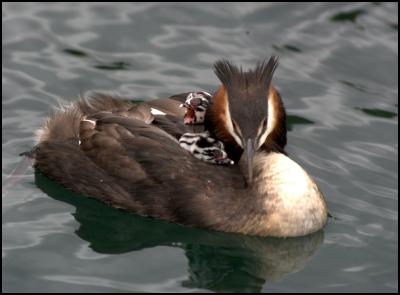Lake Wanaka grebes thrive with a bit of help
Lake Wanaka grebes thrive with a bit of help

Man-made nesting platforms have boosted Lake Wanaka’s population of endangered great crested grebes/kāmana.
Over the last two years, only one pair of grebes lived in the Roys Bay area on the lake but thanks to some innovative work by Wanaka zoologist John Darby, seven breeding pairs have nested and produced 27 chicks and a further five eggs are due to hatch.
One of the problems faced by this special water bird is they live on floating nests and Lake Wanaka’s fluctuating levels mean their nests either flood or are left high and dry. They cannot walk on land due to their anatomy – their legs are far back on their body – making them vulnerable to predators. Also, there is a lack of suitable habitat.
John said the grebes had been unsuccessful in breeding onshore, and even tried to build a nest on the back of a boat, so he has spent the past two years studying them and designing a floating wooden nesting platform. To handle the lake’s north-westerly storms, he has modified the design from being tethered by ropes and hooks to bolts and chains.
“The grebes were disturbed by well-intentioned people, and dogs, predators and changing lake levels caused problems. So I moved their nests onto platforms, towed them by kayak to the Roys Bay marina, and tethered them to the floating platform where they aren’t disturbed by predators. Surprisingly, activity on the marina doesn’t bother them and boaties have been careful around them,” John said.
Now the birds are happily breeding in the area, John is keen to involve other people in continuing conservation and management of grebes by developing a grebe reserve beside the marina.
John has a Department of Conservation (DOC) concession to trial his nest platforms. DOC Wanaka ranger Flo Gaud said John’s dedicated conservation work has led to the increase in the number of breeding pairs on the lake and she reminded people to give the nesting grebe’s some space.
–Ends–


 Gordon Campbell: On US Voter Suppression, Plus The Races To Watch
Gordon Campbell: On US Voter Suppression, Plus The Races To Watch Department of Conservation: Priority Conservation Projects Open For Donations
Department of Conservation: Priority Conservation Projects Open For Donations NZ Labour Party: Winston Peters Must Apologise
NZ Labour Party: Winston Peters Must Apologise Meat The Need: National Charity Auction To Combat Food Insecurity In New Zealand
Meat The Need: National Charity Auction To Combat Food Insecurity In New Zealand Inland Revenue Department: Inland Revenue Stops Using Custom Audience Lists
Inland Revenue Department: Inland Revenue Stops Using Custom Audience Lists Horowhenua District Council: Foxton War Memorial Hall Finds A New Life In Community Hands
Horowhenua District Council: Foxton War Memorial Hall Finds A New Life In Community Hands Council for International Development: CID & Members’ Call For Action Against UNRWA Ban In Israel And Occupied Palestinian Territories
Council for International Development: CID & Members’ Call For Action Against UNRWA Ban In Israel And Occupied Palestinian Territories


